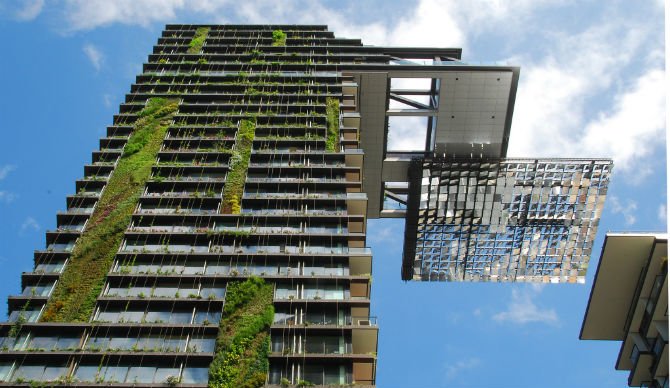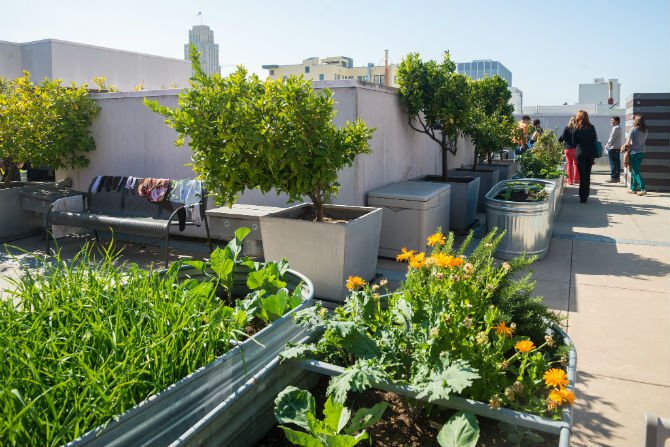I have very fond memories of helping my dad plant a garden in our backyard each summer. I’ll admit that I hated the weeding and the waiting, but I always gained satisfaction knowing that the tomatoes, peppers, lettuce, and zucchini on my plate at dinner came from right outside.
Maybe that’s why I’ve always been fascinated with growing food. But it wasn’t until going to college that I became even more intrigued by the concept of urban agriculture.
In 2008, globally the number of people living in cities exceeded the number of people living in rural areas for the first time in history. The number of city dwellers is expected to continue to skyrocket, and the UN predicts that urban populations will grow by more than one billion people between 2010 and 2025.
Shifting to urban centers can be a good thing. Cities tend to offer better opportunities for education and employment, which correlate with higher incomes and more food security. However, around one-third of the world’s labor force is made up of rural farmers, and this proportion is dwindling as urbanization trends continue.
So where is food going to come from in the future?
Some leading urban agriculturists envision city skyscrapers filled with floors of vegetable patches and orchards. Glass windows would let in optimal natural light, and conveyor belts would ensure that the plants have equal time in the sun. Others imagine cities with gardens on every rooftop. Plants would be watered naturally, and could beautify the skyline as an added bonus.

I am tempted by these visions of lush city-scapes, but there are some very serious pros and cons to urban agriculture that require consideration.
Pro: Urban agriculture has enormous production capability
Today, there are 22 countries with the capacity to feed their cities by farming on less than 10% of their urban land. Another 39% of the global population lives in countries that can feed city residents by farming on less than 25% of urban land.
Combine these statistics with the knowledge that some urban farms are currently producing over 500 pounds of food a day, and you have a recipe for growing a whole lot of food on a little bit of land.
Con: But… let’s not forget about the food pyramid
Unfortunately, estimates on how much food could be produced by urban farms do not account for nutritional recommendations on produce consumption. While 22 countries can meet their city’s produce demand with urban agriculture, only 9 can provide a truly healthy quantity of fruits and veggies. Of the 29 most food insecure nations, 23 would need to farm on over 100% of their urban land to feed those residing within cities with proper servings of produce. Not so realistic.
Pro: Local eating is good eating
City dwellers who eat locally produced food are minimizing the mileage it takes for food to get from farm to table. (Check back later this week for another article on how shipping food long distances can perpetuate poverty).
Local food is often fresher because very little time passes between harvest and consumption. Even better, local urban farms encourage the ingestion of seasonal vegetables, which are riper and more nutritious than the off-peak alternatives available in grocery stores year-round.
Con: Contaminated soil is a real threat
Unexpected items such as cars and paint can have a significant impact on the quality of city soil, and thus city produce. Tests on urban soil often reveal the presence of arsenic, lead, and heavy metals, meaning that the dirt has to be purified or removed before planting can begin. Neither of these options are particularly cost effective, and serve as a major disincentive for potential urban farmers.
If these impurities pass unnoticed, produce grown in contaminated soil can be poisonous. Eating compromised fruits and vegetables can cause serious health concerns that compromise brain, liver, and kidney functions.
Pro: Urban farming benefits city environments
Rainwater in cities typically cannot be absorbed back into the ground due the abundance of pavement and concrete. Instead, the water is syphoned off to the closest river or lake through sewage systems, where it disturbs ecosystems, deposits previously mentioned contaminants, and contributes to flooding. If cities were covered with the greenery of urban farms instead, this water could be absorbed back into the soil to prevent run off naturally.
Many cities are also overheating. Paved roofs and roads can be 50–90°F (27–50°C) hotter than the air temperature after baking in the sun all day. Urban agriculture keeps city surfaces shady and damp, minimizing increased electricity usage and health concerns such as heat stroke.

Take off your gardening gloves because urban agriculture cannot be counted on as the fuel of the future quite yet. However, safe and healthy urban farms have already sprouted in many parts of the world, and may be bringing fresh seasonal produce (and an abundance of environmental benefits) to a city near you. Let’s call it part of the solution.
If you want to be part of the solution to food security problems, sign the petition in TAKE ACTION NOW to make sure more funding and attention is paid to increasing food security around the world.